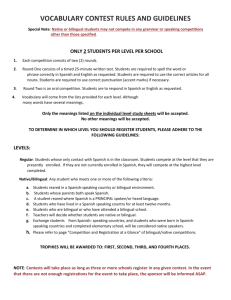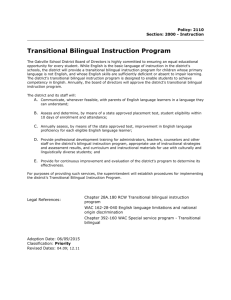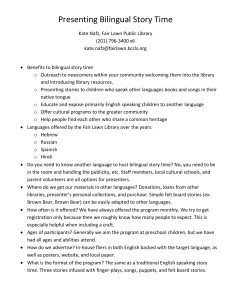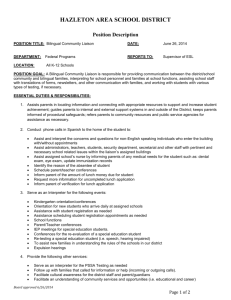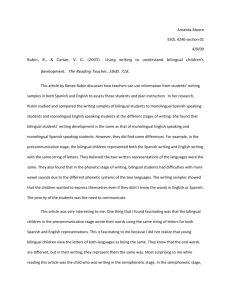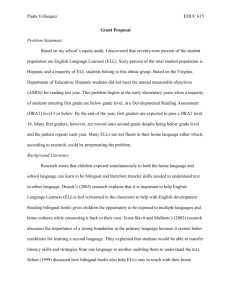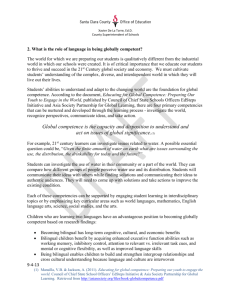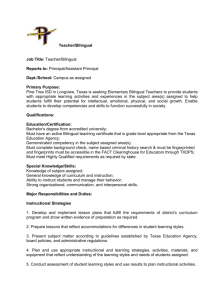File - EDS 125 Fall 2015
advertisement
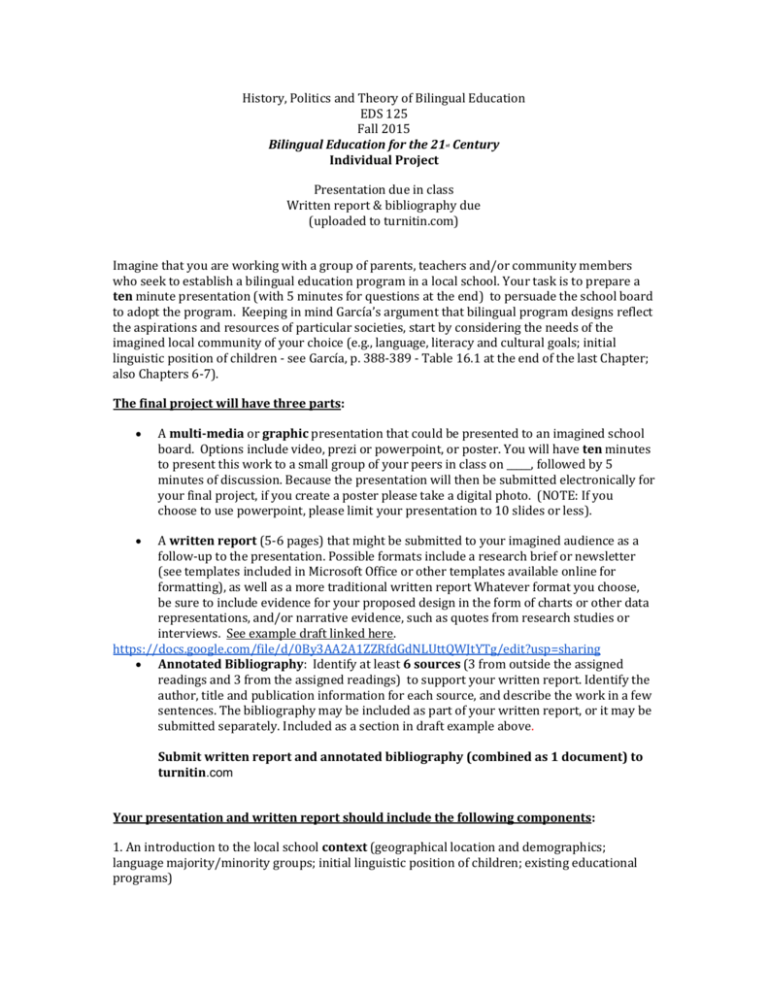
History, Politics and Theory of Bilingual Education EDS 125 Fall 2015 Bilingual Education for the 21 Century Individual Project st Presentation due in class Written report & bibliography due (uploaded to turnitin.com) Imagine that you are working with a group of parents, teachers and/or community members who seek to establish a bilingual education program in a local school. Your task is to prepare a ten minute presentation (with 5 minutes for questions at the end) to persuade the school board to adopt the program. Keeping in mind García’s argument that bilingual program designs reflect the aspirations and resources of particular societies, start by considering the needs of the imagined local community of your choice (e.g., language, literacy and cultural goals; initial linguistic position of children - see García, p. 388-389 - Table 16.1 at the end of the last Chapter; also Chapters 6-7). The final project will have three parts: A multi-media or graphic presentation that could be presented to an imagined school board. Options include video, prezi or powerpoint, or poster. You will have ten minutes to present this work to a small group of your peers in class on _____, followed by 5 minutes of discussion. Because the presentation will then be submitted electronically for your final project, if you create a poster please take a digital photo. (NOTE: If you choose to use powerpoint, please limit your presentation to 10 slides or less). A written report (5-6 pages) that might be submitted to your imagined audience as a follow-up to the presentation. Possible formats include a research brief or newsletter (see templates included in Microsoft Office or other templates available online for formatting), as well as a more traditional written report Whatever format you choose, be sure to include evidence for your proposed design in the form of charts or other data representations, and/or narrative evidence, such as quotes from research studies or interviews. See example draft linked here. https://docs.google.com/file/d/0By3AA2A1ZZRfdGdNLUttQWJtYTg/edit?usp=sharing Annotated Bibliography: Identify at least 6 sources (3 from outside the assigned readings and 3 from the assigned readings) to support your written report. Identify the author, title and publication information for each source, and describe the work in a few sentences. The bibliography may be included as part of your written report, or it may be submitted separately. Included as a section in draft example above. Submit written report and annotated bibliography (combined as 1 document) to turnitin.com Your presentation and written report should include the following components: 1. An introduction to the local school context (geographical location and demographics; language majority/minority groups; initial linguistic position of children; existing educational programs) 2. A statement of the language, literacy and cultural goals for the new program 3. A brief review of 2 successful bilingual program models that you have learned about through class readings, your own research, or through the earlier group presentations. Explain why you believe that these programs are relevant for the local context and goals and provide evidence to support your claims in the form of relevant theories AND/OR research findings. 4. Describe a proposed new bilingual program model for consideration that innovates on or replicates one of the successful models described above. Be sure to address the following: a. The rationale for the selected program model (e.g., theoretical framework, goals; type of bilingual education) b. How will the languages be allocated across the school day (e.g., language arrangement, models of billingual/biliteracy pedagogy)? Why? What are the requirements for teachers and staff that will work at your proposed school? d. How will families be actively involved? What community resources might be used? e. Describe some relevant policies or legal requirements/mandates that may impact the implementation of the model (e.g., No Child Left Behind, Prop 227, Common Core State Standards; see Chapter 8 c. Here are some resources you may find helpful in addition to the examples linked above. Suggestions for talking to School Boards ACLU - Parents’ Guide to School Board Advocacy in Washington Small Schools Project - 33 Tips for Making Presentations to School Boards Sample Research Briefs (note that some of these have much longer bibliographies than would be expected for this project as well as more extensive research reviews, and that the bibliographies here are not annotated) Iowa School Boards Foundation - Family, School & Community Connections: Improving Student Learning VL2 - Visual Language & Visual Learning Research Brief: ASL/English Bilingual Education Models, Methods & Strategies Education Alliance - Quality Bilingual Education: Defining Success LiteracySquared.org - Literacy Squared®: Building Trajectories Toward Biliteracy Handout Information on Bilingual Program Effectiveness 1. San Diego County Office of Education (2006): Successful Bilingual Programs in California: Six Effective Programs (Includes achievement data and case studies) Program Languages Type(s) of BE Breeze Hill Elementary, Vista USD Spanish, English Transitional Cahuenga Elementary, Los Angeles USD Spanish, Korean, English Spanish/Eng: Transitional/Developmental Korean/Eng: Dual Language (some students in tri-lingual program) Gascon Elementary, Montebello USD Spanish, English Transitional Larsen Elementary, Hueneme ESD Spanish, English Transitional Olivewood Elementary, National SD Spanish, English Transitional San Fernando Elementary, LAUSD Spanish, English Transitional 2. San Diego County Office of Education: Dual Language Directory (see School Accountability Report Cards on school websites for program effectiveness information) 3. Center of Applied Linguistics Directory of Two-Way Bilingual Immersion Programs in the United States 4. California Schools for the Deaf and other resources 5. Heritage Language Program Directory (Center for Applied Linguistics; Contains examples of programs in K-12, University and community-based settings) 6. Programs for Emergent Bilinguals (“Newcomers”): Bridges and Newcomers High School (New York City) - student oral histories Short & Boyson (2012) Helping Newcomer Students Succeed in Secondary Schools and Beyond Center for Applied Linguistics. (Contains case studies of exemplary programs across the US) 7. Global examples by program type: See García, Chapter 8 (US); 9 (EU); 10 & 11 (Global) 8. There are additional resources on line
